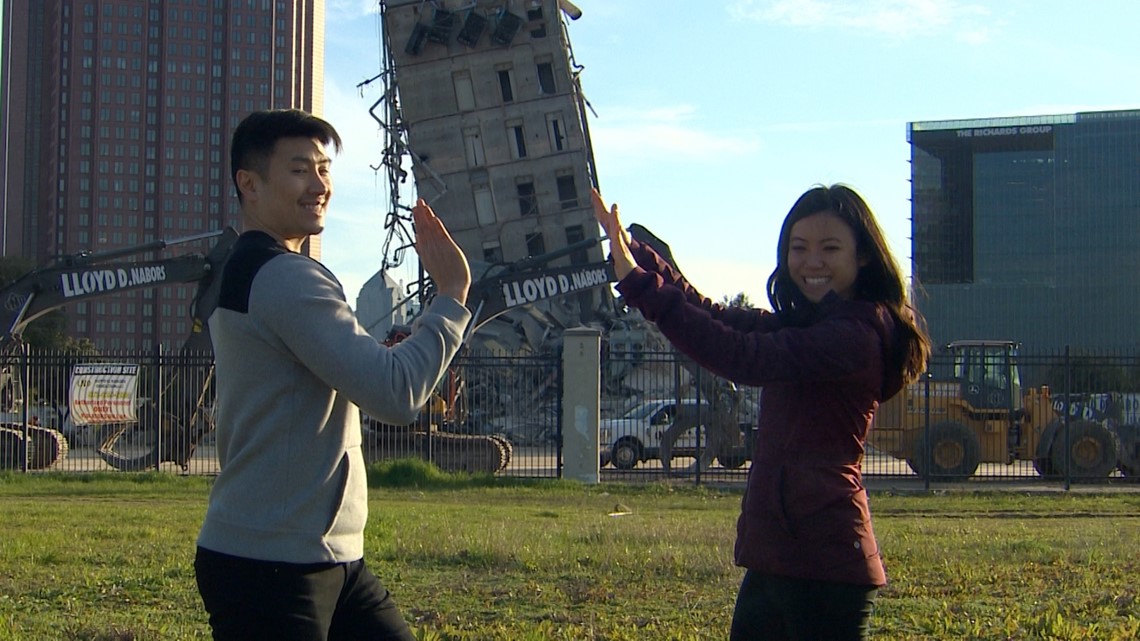Rising from the haze of the demolition stood a single leaning tower, the core shaft of the building. It was still standing.
DALLAS — Watch our “Leaning Tower of Dallas: A Flashback Special” on WFAA+ at 6:30 p.m. Sunday. Don’t have WFAA+? Here’s how you can download and install it on your smart TV.
The explosives fired at 7:45 a.m. on a crisp, sunny Sunday morning in February. They had one job: Bring down the most nondescript of nondescript Dallas office buildings, an 11-story hunk of concrete and glass on a mostly vacant lot near U.S. 75 and Haskell Avenue. For the most part, the dynamite did its job.
Stacks of concrete and glass crumbled into dust, sending a plume over the highway toward Uptown. A small crowd that had gathered to watch the implosion cheered.
“Wow!” someone screamed.
Then the dust settled lower as the surrounding edge of the building had fallen.
“Uh-oh,” another person could be heard on the footage. “It didn’t fall.”
Rising from the haze of the demolition stood a single leaning tower, the core shaft of the building. It was leaning the direction the crews had intended — shifting just slightly to the east, at no risk of toppling onto U.S. 75 — but it didn’t fall.
And so began the city’s two-week infatuation with “The Leaning Tower of Dallas.”
Sunday marks five years since that fateful morning, when the tower didn’t fall. It might as well have been a lifetime ago.
Feb. 16, 2020, was mere weeks before the COVID-19 pandemic, which would force us all indoors for weeks. The routine building demo-gone-awry drew national attention — ABC News accurately called it a “stubborn structure” — and, oddly enough, struck a chord with the collective hearts of Dallas.
As construction crews strategized on how to bring the building to its knees, North Texans flocked to the open lot near the tower, creating the perfect Instagram-worthy spot for a photo shoot, a la the Leaning Tower of Pisa in Italy. There was something very Dallas about the whole thing: A city of constant construction and teardowns and redevelopment, discovering a communal experience over the demolition of a building that was being cleared for a proposed billion-dollar mixed-used project.
Whew, that’s a mouthful. But it takes a lot to encapsulate this strange moment in Dallas history. Did it change any lives? Probably not. Was it worthy of our top 75 moments in North Texas in the last 75 years? We certainly thought so, and penciled it in at No. 75.


About a week after the failed demolition, crews returned with a 5,600-pound wrecking ball, a safer approach to tearing down the remaining structure of the building. Thomas Taylor, one of the original design engineers for the tower, explained to WFAA at the time why crews had such trouble bringing down the core of the building.
“A cast-in-place concrete core,” Taylor said. “We call it a slip-form concrete core. And that became the stabilizing element for the building. So it’s sort of like the tree trunk of a tree. I mean, what came off is all the branches and the leaves. But the tree trunk is a little harder to bring down than the branches.”
But the wrecking ball wasn’t the easiest of solutions, either. Wind gusts grounded the wrecking ball one day, making it unsafe to use, and repeated hits to the building weren’t enough to knock the tower over.
Eventually, on March 2, 2020, a few more thumps from the wrecking ball got the job done. The tower crumbled at 3:18 p.m.
Lloyd Nabors Demolition, one of the main companies involved in the demolition project, confirmed the tower came down within the confines of the original job site. Nothing outside of the construction area was impacted, except the hearts and minds of Dallasites.